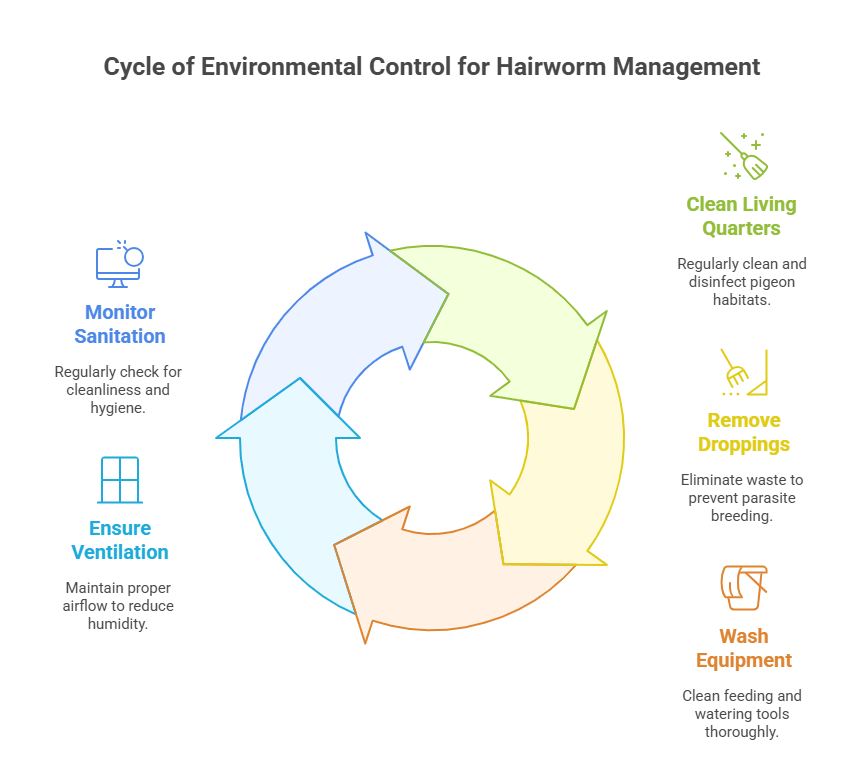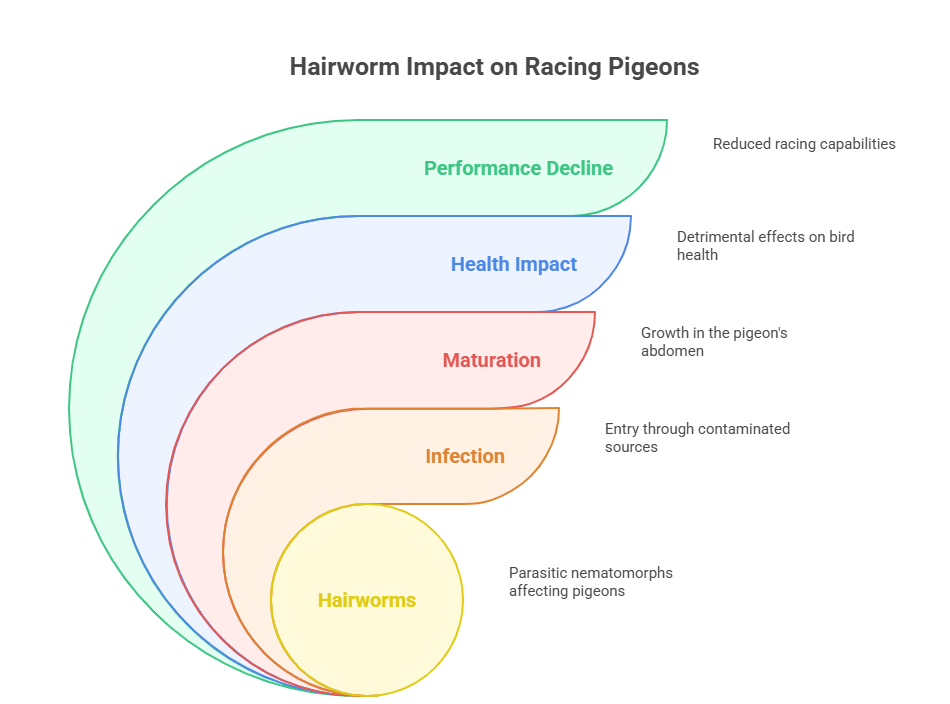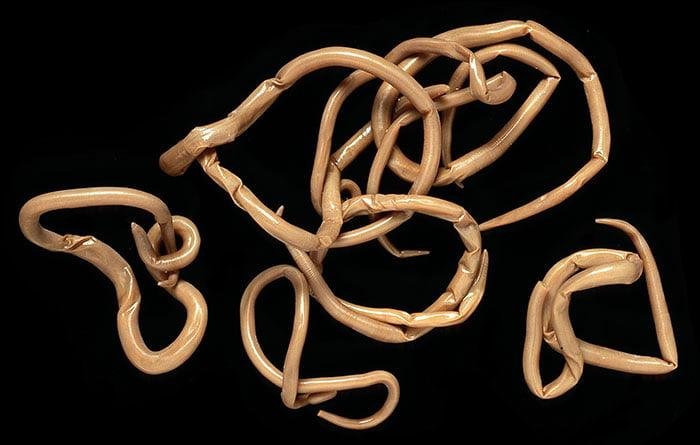The Life of Racing Pigeons: An Overview
Additionally, various events and races are held annually, fostering camaraderie among competitors and allowing for the celebration of these extraordinary birds. Understanding the complete life cycle of racing pigeons, from breeding to racing, lays the groundwork for recognizing the potential threats they face, such as parasites like hairworms in racing pigeons, which can undermine their performance and overall health.
BUY IT HERE 2
BUY IT HERE 3
The Menace of Hairworms Roundworms: What They Are and Their Impact
Hairworms, scientifically classified as nematomorphs, are parasitic organisms primarily known for infecting a variety of host species, including racing pigeons.

These slender, worm-like parasites typically enter their avian hosts through contaminated water or food, becoming a significant concern for bird enthusiasts. Once inside the host, hairworms begin their lifecycle by maturing in the pigeon’s abdomen, where they can grow to impressive lengths. This parasitic relationship is distinctly detrimental to racing pigeons, as the hairworms can affect the bird’s overall health and performance.
As they develop, hairworms can invoke various symptoms in infected racing pigeons, which may include lethargy, uncoordinated movements, and a general decline in health. Affected pigeons may exhibit unusual behaviors such as restlessness or isolation from their flock. Pigeon owners often report a decrease in flight performance, with infected birds appearing unable to compete effectively. These health issues can severely hinder not only the pigeons’ well-being but also the competitive edge of racing teams, making awareness of hairworms crucial for anyone involved in the racing pigeon community.
The lifecycle of hairworms is intriguing yet alarming. Once mature, these parasites can manipulate their hosts’ behavior to increase their chances of transmission. A hairworm-infected pigeon may seek water sources more frequently, where the mature worm will emerge into the environment to seek out new hosts, continuing the cycle. The interaction between racing pigeons and hairworms highlights the critical importance of monitoring flock health and implementing preventive measures. Awareness of these parasites and their impacts is essential for pigeon enthusiasts, offering insight into safeguarding their birds and ensuring the integrity of the racing community.
Detecting Hairworm Roundworms Infestations in Racing Pigeons
Identifying hairworm infestations in racing pigeons can be challenging, as the early symptoms may be subtle or mistaken for other health issues. Owners should be vigilant and continuously monitor their pigeons for any signs of distress or abnormal behavior. Common indicators of hairworm infections include excessive preening, weight loss, lethargy, and changes in appetite.

Additionally, affected birds may exhibit a decrease in performance during races, which can often be one of the first observable signs of underlying health issues such as hairworm infestations.
Physical appearance can also offer clues to potential infestations. Infected pigeons may present with a dull and unkempt plumage, as the worms can affect nutrient absorption essential for feather health and vitality. Droppings may become abnormal in color or consistency, indicating possible digestive troubles linked to hairworms. Regular observation of these behavioral and physical changes is crucial for early detection and intervention.
Due to the intricate life cycle of hairworms in racing pigeons, early detection is often complicated. Because pigeons can exhibit varying degrees of susceptibility, some birds may show symptoms while others remain asymptomatic, making it essential for pigeon owners to maintain a consistent health monitoring regime. Routine veterinary check-ups should not be overlooked, as professionals can conduct fecal examinations to confirm the presence of hairworms and provide appropriate treatment options. Implementing preventive measures, such as maintaining a clean living environment and optimizing nutrition, also plays a significant role in reducing infection risks, ensuring the health and performance of racing pigeons.
Effective Treatments and Prevention Strategies for Hairworm Roundworms Infections
Managing hairworm infections in racing pigeons requires a multifaceted approach that integrates both traditional and modern treatment options. First and foremost, anti-parasitic medications are widely recognized as the primary means of eliminating hairworms. These medications can effectively target the adult and larval stages of the parasites, reducing their numbers and alleviating the associated symptoms in affected birds. Veterinary guidance is essential in selecting the appropriate medication, as the specific treatment may vary depending on the severity of the infection and the health status of the pigeons.

In addition to pharmacological treatments, environmental control measures play a crucial role in managing hairworm infections. Regularly cleaning and disinfecting the living quarters of racing pigeons significantly reduces the chances of reinfestation. Implementing a routine that includes removing droppings, washing feeding and watering equipment, and ensuring proper ventilation can create an inhospitable environment for hairworms. Also, monitoring the sanitation of the pigeons’ surroundings is crucial, as a clean environment supports their overall health and minimizes exposure to parasites.
Best practices for maintaining the health of racing pigeons can further complement treatment efforts. A well-balanced diet enriched with essential vitamins and minerals boosts the immune system, helping pigeons resist infections more effectively. Providing fresh water and adequate space for exercise also contributes to their overall well-being. Furthermore, pigeon owners are encouraged to conduct regular health checks to detect early signs of hairworm infestations or other potential health issues.
Preventive measures remain the cornerstone of effectively managing the risk of hairworm infections. These include avoiding overcrowding, regular veterinary check-ups, and maintaining biosecurity protocols during bird shows or races. By adopting these comprehensive strategies, pigeon owners can promote a healthier racing environment and enhance the overall welfare of their birds.

